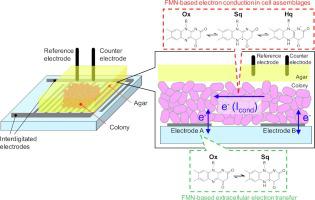当前位置:
X-MOL 学术
›
Electrochem. Commun.
›
论文详情
Our official English website, www.x-mol.net, welcomes your feedback! (Note: you will need to create a separate account there.)
Variations in flavin redox states during extracellular electron transfer and electron conduction in Shewanella oneidensis
Electrochemistry Communications ( IF 4.7 ) Pub Date : 2024-05-10 , DOI: 10.1016/j.elecom.2024.107751 Yoshihide Tokunou , Hiromasa Tongu , Masanori Toyofuku , Nobuhiko Nomura
Electrochemistry Communications ( IF 4.7 ) Pub Date : 2024-05-10 , DOI: 10.1016/j.elecom.2024.107751 Yoshihide Tokunou , Hiromasa Tongu , Masanori Toyofuku , Nobuhiko Nomura

|
Flavin is one of the most prevalent redox molecules utilized by electroactive bacteria. Electroactive bacteria form a three-dimensional architecture with multiple cell assemblages on electrodes in bioelectrochemical systems. This provokes the importance of unveiling the redox chemistry of flavins during electron transfer not only at the bacteria/electrode interface but also inside cell assemblages. However, it has been difficult to directly compare the redox species contributing to each electron transfer reaction. In this study, to simultaneously detect the flavin redox species at the electrode surface and those in cell assemblages, we conducted bipotentiometric cyclic voltammetry on a colony of MR-1. The bipotentiometric data showed that flavin mononucleotide proceeds the redox cycle at − 0.43 V (vs. standard hydrogen electrode) in the MR-1 colony assignable to the semiquinone/hydroquinone redox cycle, which was supported by experiments with semiquinone scavenger and gene deletion mutants. Notably, the peak at − 0.43 V was not detected at the electrode surface, indicating that the flavin redox cycles and redox potentials involved in the electron transfer inside MR-1 assemblages differ from those at the MR-1/electrode interface. The measurement system presented herein offers a platform to clarify the redox reactions in cell assemblages as well as at the bacteria/electrode interface.
中文翻译:

希瓦氏菌细胞外电子转移和电子传导过程中黄素氧化还原态的变化
黄素是电活性细菌最常用的氧化还原分子之一。电活性细菌在生物电化学系统的电极上形成具有多个细胞组合的三维结构。这激发了揭示电子转移过程中黄素氧化还原化学的重要性,不仅在细菌/电极界面,而且在细胞组合内部。然而,直接比较有助于每个电子转移反应的氧化还原物质是很困难的。在本研究中,为了同时检测电极表面和细胞组合中的黄素氧化还原物质,我们对 MR-1 菌落进行了双电位循环伏安法。双电位数据显示,黄素单核苷酸在 MR-1 菌落中以 − 0.43 V(相对于标准氢电极)进行氧化还原循环,可分配给半醌/氢醌氧化还原循环,这得到了半醌清除剂和基因缺失突变体实验的支持。值得注意的是,在电极表面没有检测到 - 0.43 V 处的峰值,这表明 MR-1 组合内部电子转移所涉及的黄素氧化还原循环和氧化还原电位与 MR-1/电极界面处的不同。本文提出的测量系统提供了一个平台来阐明细胞组合以及细菌/电极界面处的氧化还原反应。
更新日期:2024-05-10
中文翻译:

希瓦氏菌细胞外电子转移和电子传导过程中黄素氧化还原态的变化
黄素是电活性细菌最常用的氧化还原分子之一。电活性细菌在生物电化学系统的电极上形成具有多个细胞组合的三维结构。这激发了揭示电子转移过程中黄素氧化还原化学的重要性,不仅在细菌/电极界面,而且在细胞组合内部。然而,直接比较有助于每个电子转移反应的氧化还原物质是很困难的。在本研究中,为了同时检测电极表面和细胞组合中的黄素氧化还原物质,我们对 MR-1 菌落进行了双电位循环伏安法。双电位数据显示,黄素单核苷酸在 MR-1 菌落中以 − 0.43 V(相对于标准氢电极)进行氧化还原循环,可分配给半醌/氢醌氧化还原循环,这得到了半醌清除剂和基因缺失突变体实验的支持。值得注意的是,在电极表面没有检测到 - 0.43 V 处的峰值,这表明 MR-1 组合内部电子转移所涉及的黄素氧化还原循环和氧化还原电位与 MR-1/电极界面处的不同。本文提出的测量系统提供了一个平台来阐明细胞组合以及细菌/电极界面处的氧化还原反应。











































 京公网安备 11010802027423号
京公网安备 11010802027423号